Wine Shades by the Eyes of a Colour blind
by KOTE SULABERIDZE
28.06.2014 -30.06.2014
Vinopolis, London
Curated and funded by cARTveli art Foundation. Supported by Georgian Embassy in the UK and BGCC
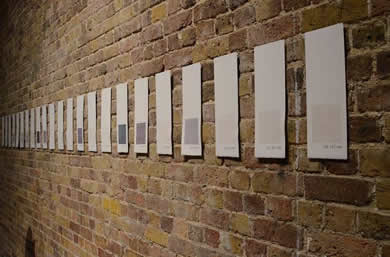 Kote Sulaberidze is a leading artist from Georgia. With his multidisciplinary art he investigates the resonating issues of Georgian reality. The exhibition Wine Shades by the Eyes of a Colour-blind focuses on the vital constituents of Georgian social culture- the wine and the Supra. Etymologically Supra means a tablecloth; however, it has come to signify the dinner parties that revolve around the mounts of food, reckless wine drinking and elaborate stories told as toasts. South Caucasus, the geographical location of Georgia is considered to be the first source of cultivated vineyards dating back over 8000 years. With 400 grape varieties grown in the country, Georgians produce 38 sorts employing the winemaking method (now protected by UNESCO). Apart from aroma and taste, colour is a leading criterion of wine evaluation. Supras stained with red wine inspired Kote to produce a visual archive of the traces Georgian wines leave on paper. The sequence of lyrical, semi-transparent tones, the Wine Shades is accompanied by the information about the vine sorts, the year and precise locations of harvest. The visitors will have a chance to familiarise themselves with the archive of this pseudo-scientific research.
Kote Sulaberidze is a leading artist from Georgia. With his multidisciplinary art he investigates the resonating issues of Georgian reality. The exhibition Wine Shades by the Eyes of a Colour-blind focuses on the vital constituents of Georgian social culture- the wine and the Supra. Etymologically Supra means a tablecloth; however, it has come to signify the dinner parties that revolve around the mounts of food, reckless wine drinking and elaborate stories told as toasts. South Caucasus, the geographical location of Georgia is considered to be the first source of cultivated vineyards dating back over 8000 years. With 400 grape varieties grown in the country, Georgians produce 38 sorts employing the winemaking method (now protected by UNESCO). Apart from aroma and taste, colour is a leading criterion of wine evaluation. Supras stained with red wine inspired Kote to produce a visual archive of the traces Georgian wines leave on paper. The sequence of lyrical, semi-transparent tones, the Wine Shades is accompanied by the information about the vine sorts, the year and precise locations of harvest. The visitors will have a chance to familiarise themselves with the archive of this pseudo-scientific research.
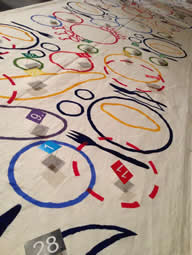 Already a student at the Tbilisi Academy of Arts, Kote had accidentally discovered his colour blindness, while applying for his driving licence. Ever since, the condition became the subject of his oeuvre and research. One of his other reoccurring themes is the traditional cuisine and Supra. Bespoke for their hospitality, Georgians love showing their reverence for guests through the abundant amount of food at dinner parties. Indeed, in Georgian culture the banal activity of eating is elevated to a ritual accompanied by a hierarchy of toasts. Kote’s scrupulously painted dishes invite audience to fish for humorous, cynical or heartfelt undercurrents. However, the Supra presented on this exhibition will counter the usually elaborate depictions and instead focus on portraying the gastronomic sensations in colours. The table is laid for 13 people; a mere coincidence, dictated by the length of the cloth involuntarily evokes the single most important dinner party of Christianity. The painter now delves into the world of cartography and maps the locations where the dishes are placed on Supras. This mock-serious approach leaves it upon the viewers to evoke the mouth-watering memories of nourishing khachapuri and steaming Khinkali and reconstruct the image. True to every map, the accompanying menu explains the signs and abbreviations. Supra similar to the most of the traditions, has turned into a battlefield contested with socio-political implications. Kote, on the other hand lays the table for the audience to imagine the delicious food, passionate debates and slightly rude comments interrupting the toasts.
Already a student at the Tbilisi Academy of Arts, Kote had accidentally discovered his colour blindness, while applying for his driving licence. Ever since, the condition became the subject of his oeuvre and research. One of his other reoccurring themes is the traditional cuisine and Supra. Bespoke for their hospitality, Georgians love showing their reverence for guests through the abundant amount of food at dinner parties. Indeed, in Georgian culture the banal activity of eating is elevated to a ritual accompanied by a hierarchy of toasts. Kote’s scrupulously painted dishes invite audience to fish for humorous, cynical or heartfelt undercurrents. However, the Supra presented on this exhibition will counter the usually elaborate depictions and instead focus on portraying the gastronomic sensations in colours. The table is laid for 13 people; a mere coincidence, dictated by the length of the cloth involuntarily evokes the single most important dinner party of Christianity. The painter now delves into the world of cartography and maps the locations where the dishes are placed on Supras. This mock-serious approach leaves it upon the viewers to evoke the mouth-watering memories of nourishing khachapuri and steaming Khinkali and reconstruct the image. True to every map, the accompanying menu explains the signs and abbreviations. Supra similar to the most of the traditions, has turned into a battlefield contested with socio-political implications. Kote, on the other hand lays the table for the audience to imagine the delicious food, passionate debates and slightly rude comments interrupting the toasts.
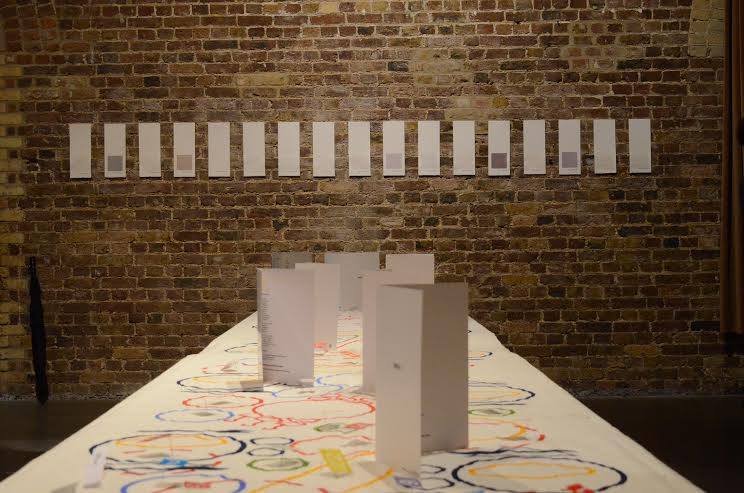 |
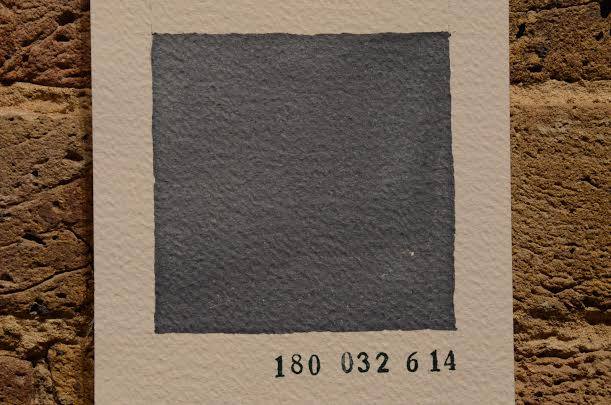 |
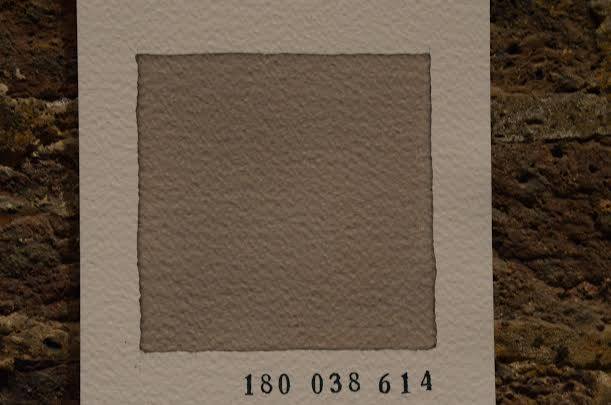 |
